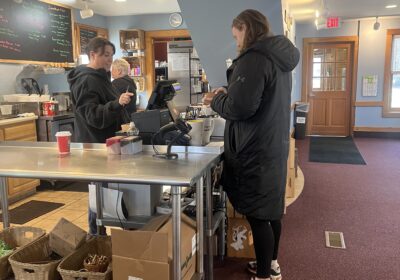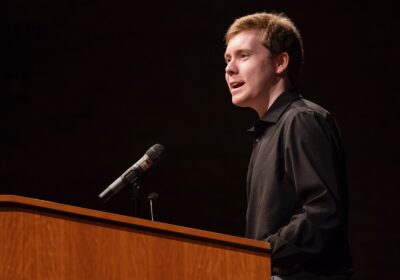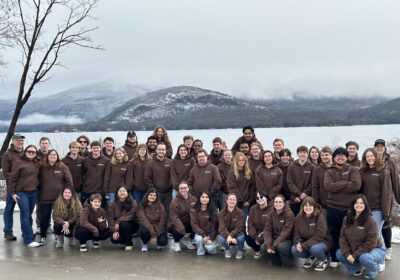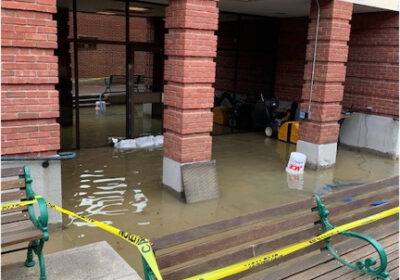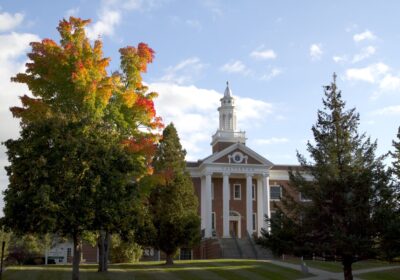Castleton feels growing pains

As Castleton increases enrollment and programs, students worry the university will outgrow itself. Students eat in a crowded Huden dining hall.
While on a tour of the Castleton State College campus in 2001, newly hired college President Dave Wolk noted all the improvements the campus needed. It needed a renovated theater, newer residence halls and more dining options.
But what the school of about 1,300 students needed most was signage. From Main Street there was no way of knowing where this small campus was or what was going on.
Today, there is no mistaking Castleton University’s location within the small town of Castleton, Vermont. Signs along the street clearly indicate entrances to the campus, banners hang from streetlights and folding signs usher guests to parking for special events year-round.
The university’s presence is even felt in nearby Rutland: home to Spartan Stadium, the Castleton Polling Institute, Castleton Downtown Offices, the Castleton Downtown Art Gallery and recently opened this fall, Foley Hall.
But as Castleton’s enrollment grows, now at roughly 2,200 students, the question on the minds of many becomes how big is too big?
The goal, as stated in the Castleton Plan, is incremental growth over 10 years to 2,500 students, including graduate students, part time students and students living in off-campus housing.
“We have reached the capacity of our footprint here in Castleton. We would be interrupting beautiful green space if we grew anymore,” Wolk confirmed. “There will be no future growth on campus.”
One area students see space getting tight is in the residence halls where the Ellis common rooms have been turned into triples and nearly every bed on campus is filled.
There are between 1,100 and 1,300 beds available on campus depending on how many singles, doubles and triples there are, according to Director of Housing Mike Robilotto.
Castleton offers guaranteed housing all four years, but with the increased enrollment, students wonder where all these new students will be housed.
“Housing is a need for sure, especially if we keep getting more people. We can’t just put them in apartments 20 minutes away from campus with a bus that comes through a handful of times a day,” sophomore Kyle McCarthy said. “If we’re going to add a lot more students, which is great, we need to add more space, but we can’t and that’s the problem.”
Robilotto assures that housing will still be available to all no matter how many people want to live in campus housing.
“Everyone who pays a housing deposit gets housing,” he said explaining how students with higher priority numbers get first choice of rooms, followed by students with lower numbers, and finally first year and transfer students. “We would start a waiting list if the rooms filled up, but we have never reached that point.”
He referred to the situation in fall of 2013 where forced triples were made in Castleton Hall and North, South, and Audet houses. The lounges in Ellis were also made into triples and there were very few single rooms on campus. And even that year, they didn’t need a waiting list.
Something Castleton didn’t have in 2013 is Foley Hall, the new university housing in Rutland.
Foley Hall, which opened this fall, houses 39 upper class and graduate level students who represent five countries and 16 states, according to Wolk.
Robilotto said it gives students a nice option if they want to live off campus in their own space, but have Castleton as their landlord. Students in Rutland are also on the Castleton Wi-Fi system and use scan cards to enter the building like they would a residence hall on campus.
Helen Bearse is living in the Foley Hall apartments and says that it is a great option for her.
“I love living in the apartments so far. I’m out student teaching and I can walk to my school placement in 10 minutes because the apartments are right in the downtown,” she said. “It’s been amazing so far.”
There is talk of obtaining more property in Rutland to be used as housing, but Robilotto said that there is no real plan at the moment.
Wolk explained another motivation for the growth into Rutland, besides the need for more space.
“We have a beautiful, bucolic campus. Very rural. We want to give students the option, or Vermont’s version, of an urban environment. And downtown Rutland is as close as we’ll get,” he said.
Regardless of what’s happening in Rutland, students are noticing the increased population on campus, most notably in dining areas at peak times.
“Peak hours are Tuesday and Thursday at noon and again in the evening at 5:30 p.m. This semester it is also fairly busy right at 7 p.m. due to the athlete schedules,” said Sodexo General Manager Rob MacFarlane.
“I definitely avoid the dining hall during the normal eating times because it’s typically too crowded,” said senior Kayla Wood. “Plus, I think there aren’t enough options for the amount of students we have.”
According to MacFarlane, there are 1,072 students on resident meal plans and 241 on commuter plans. Huden was renovated in the summer of 2013 and while he said there is often talk of another dining option coming to campus, nothing is in the works right now.
Students are also noticing a crunch in the parking lots.
“At times I realize there are no more parking spots and you have to park in Africa (South Street Lot),” said Junior Isaiah Lamos. “It doesn’t seem fair that we have to park there even as upperclassmen.”
Keith Molinari, director of Public Safety, explained that it’s not that there’s no parking, just less parking in popular lots.
On a Monday morning at 11:30 a.m., this reporter went on a parking lot round with Molinari and counted over 120 parking spaces open on campus. Most of the open spots are in South Street Lot at the south end or in the Stafford day lot behind the library, places that take longer for students to get to.
“I have been selling the South Street Lot. It’s the only completely camera-ed lot. No other lot has that safety and coverage,” he explained.
While this year’s incoming class was slightly larger than the past two years, Molinari also mentioned the 2013-2014 school year’s large enrollment saying that we are not at that level and about the same percentage of first-year students have cars on campus as other years.
“We are tight, but nowhere near full,” he added. “If we had to we could say no cars for first-year students, but we aren’t at that point.”
Although students have concerns about the rapid growth of the campus, administrators are adamant that there are plenty of options for expansion, even if growth on campus has reached its end.
“We are not going to outgrow ourselves!” Wolk confidently stated. “You can assure your friends. We will not outgrow ourselves.”

